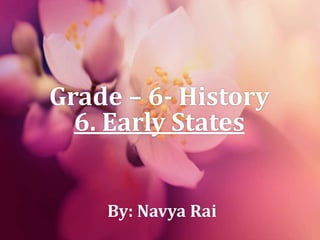
6. Early states
- 1. Grade – 6- History 6. Early States By: Navya Rai
- 2. Introduction • Around 3000 years ago, we found some changes had taken place in the ways in which rajas were chosen. • Some men were then recognised as rajas by performing very big sacrifices. • Ashvamedha or horse sacrifice was one such ritual in which a horse was let loose to wander freely and it was guarded by the raja’s men. • If the horse wandered into the kingdoms of other rajas and they stopped it, they had to fight. • If they allowed the horse to pass, it meant that they accepted that the raja who wanted to perform the sacrifice was stronger than them. These rajas were then invited to the sacrifice. • The raja who organised the sacrifice was recognised as being very powerful and all those who came brought gifts for him.
- 3. Janapadas The rajas who performed big sacrifices were then recognised as being rajas of janapadas rather than janas. The word janapada means the land where the jana set its foot and settled down. Archaeologists have excavated a number of settlements in these janapadas such as Purana Qila in Delhi, Hastinapura near Meerut, and Atranjikhera near Etah.
- 4. Conti…. They found that people lived in huts, and kept cattle as well as other animals. They also grew a variety of crops such as rice, wheat, barley, pulses, sugarcane, sesame and mustard. They made earthen pots. One special type of pottery found at these sites is known as Painted Grey Ware.
- 5. Mahajanapadas About 2500 years ago, some janapadas became more important than others, and were known as mahajanapadas. Most mahajanapadas had a capital city, many of these were fortified which means that huge walls of wood, brick or stone were built around them. Forts were probably built because: People were afraid of attacks from other kings and needed protection.
- 6. Conti….. Some rulers wanted to show how rich and powerful they were by building large, tall and impressive walls around their cities. The land and the people living inside the fortified area could be controlled more easily by the king. Building such huge walls required a great deal of planning. The new rajas began maintaining armies. Soldiers were paid regular salaries and maintained by the king throughout the year.
- 7. Taxes • The rulers of the mahajanapadas were building huge forts and maintaining big armies so they needed more resources. To meet their requirement they started collecting regular taxes. 1. Taxes on crops were collected from peoples because most people were farmers. Usually, the tax was fixed at 1/6th of what was produced. This was known as bhaga or a share. 2. There were taxes on crafts persons as well. These could have been in the form of labour. 3. Herders were also expected to pay taxes in the form of animals and animal produce. 4. There were also taxes on goods that were bought and sold through the trade. 5. Hunters and gatherers also had to provide forest produce to the raja as tax.
- 8. Changes in Agriculture • There were two major changes in agriculture around mahajanapadas time. • Growing use of iron ploughshares: This means heavy, clayey soil could be turned over better than with a wooden ploughshare so that more grain could be produced. • People began transplanting paddy. This meant that instead of scattering seed on the ground, saplings were grown and then planted in the fields.
- 9. Emergence of Towns And Cities • The origin of town was not uniform. • Some grew out of administrative centers and were hub of political powers such as Hastinapur, Magadha and Sravasthi. • Other town emerged out of markets . • They catered to the villages. Such towns wore usually located where there was an agricultural surplus which could result into barter- nexus.
- 10. A closer look – Magadha • Magadha became the most important mahajanapada in about 200 years. • Many rivers such as the Ganga and Son flowed through Magadha which play an important role for: 1. Transport 2. Water supplies 3. Making the land fertile
- 11. Conti…. • Parts of Magadha were forested which was used for building houses, carts and chariots. There were iron ore mines in the region that could be tapped to make strong tools and weapons. 1. Magadha had two very powerful rulers, Bimbisara and Ajatasattu, who used all possible means to conquer other janapadas. 2. Rajagriha (present-day Rajgir) in Bihar was the capital of Magadha for several years. Later the capital was shifted to Pataliputra (present-day Patna).
- 12. A closer look – Vajji • Vajji, with its capital at Vaishali (Bihar), was under a different form of government, known as gana or sangha. • In a gana there were many rulers. Each one was known as a raja. • These rajas performed rituals together. • They also met in assemblies, and decided what had to be done and how, through discussion and debate.
- 13. Widespread Use of Iron • Archaeological excavations show that there was a quantitative and qualitative increase of iron artefacts. • Iron vessels and nails have been uncovered from these sites. • The use of iron changed agriculture production.
- 14. Social Order • The family or the kula was the basic unit of society and was headed by kulapa or the eldest male of the family. • He was called gahapati or Kutumbika. • Apart from the four main castes, which were now rigidly based on birth, we hear of the rise of a number of jatis in this period. • Upper caste people enjoyed power and prestige. • The Shudras were considered fit for manual work and expected to serve the upper castes. • The “Chandalas” a new jati came up in this period. ( Who were considered to be outside of 4 varnas.)
- 15. Thank You
